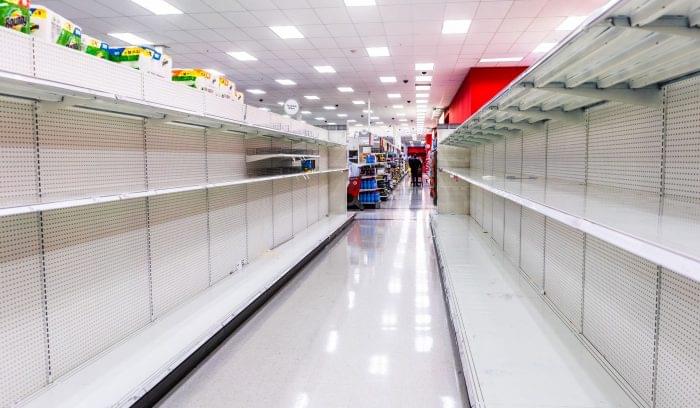The COVID-19 pandemic shined a bright light on the fragility of many businesses’ supply chains. During the first nine months of 2020, there were 4,200 supply chain disruptions — a 14 percent increase over 2019 numbers. In order for businesses to be successful in the face of future disasters, they have to build a resilient supply chain that allows them to quickly address shortages and demand changes.
How did COVID-19 create supply chain disruptions?
Between factory closures and shift workers calling off sick, COVID-19 made it difficult for manufacturers to keep up with demand for many products. And when employees could come back to work, factories laid off workers or cut hours to be able to keep workers in the factories approximately six feet apart. Now that these factories can support full workforces again, they’re having trouble replenishing the workers they dismissed or lost.
Not only were there fewer workers to complete the orders, but product demands were also changing. For example, many tech companies are still facing shortages of chips and graphics cards because consumers needed the technology to work remotely and PC gaming was a hobby people could enjoy safely at home and stay connected to friends and family. Additionally, the need for cleaning products like Clorox wipes and hand sanitizer rose astronomically, and the factories weren’t prepared for the level of demand they saw.
Businesses with manufacturing plants in China suffered from increased trade restrictions and longer wait times as products had to quarantine. Many consumers purchasing from overseas countries are still feeling the delays.
Also Read: 5 Ways to Repair Your Supply Chain
Companies that demonstrated supply chain resilience
Luckily, not all companies suffered from supply chain issues. Many liquor distilleries, including Bacardi and Buffalo Trace, diverted some of their product lines to make hand sanitizer rather than liquor to meet the heightened need.
Also Read: Industry Selling on Pause? Rethink Your Targeting
Additionally, some companies decided to start manufacturing their products domestically in order to avoid the delays that come with importing products from overseas. Nanotronics, a company that produces single patient, reusable devices that enable clinicians to follow medical protocol for non-invasive ventilation produces its product in Brooklyn, NY. “I suffered from COVID-19 myself and know first-hand how much the ventilator shortage is impacting medical facilities,” says Dr. Matthew Putnam, CEO of Nanotronics. “By manufacturing directly from Brooklyn, NY, we are able to surpass the ventilator supply chain shortage and get people the help they need.”
Many of the largest ventilator manufacturers are located in Europe, adding customs delays on top of supply shortages for US hospitals. Plus, these manufacturers are likely to prioritize hospitals in their own countries to prevent tariffs and aid their own populations, leaving hospitals in the United States scrambling.
How to make your supply chain more resilient
Supply chain disruptions don’t have to be devastating for businesses. There are several options for organizations looking to create a more flexible and resilient supply chain.
Create an omnichannel supply chain
Online shopping has grown in recent years, and COVID-19 only accelerated that growth. Retail organizations should consider adding an online store if they haven’t already. By providing multiple channels for their customers, they continue making sales, even when stores can’t be open or have limited capacity.
Also Read: Creating an Omnichannel Supply Chain: A Macy’s Case Study
Stock up on raw materials with multiple uses
Like the distilleries did, consider diversifying your product lines when possible and stock up on raw materials that you can use in multiple products, especially if they don’t expire. Bar closures reduced the need for drinking alcohol, so the distilleries instead directed some of that alcohol towards the production of hand sanitizer.
In the graphics card shortage, however, companies didn’t have the same luxury of stocking up. While they don’t expire in the traditional sense, the technology changes so rapidly that a manufacturer’s current stock could get outdated quickly.
Take stock of the materials you currently have on hand and determine which of them you have multiple uses for and the equipment needed to make something else from it. While shoe factories and hose manufacturers both use rubber, the shoe factory would be more likely to have the machinery needed to make tires if there was a shortage because both tires and shoes have treads.
Use supply chain management software with AI
Artificial intelligence (AI) can help you better navigate supply chain disruptions because it’s often able to identify them earlier than traditional forecasting methods. Rather than relying solely on historical data, supply chain management (SCM) software that includes AI examines a combination of historical data, current market trends, and external factors that can affect demand, like natural disasters. This provides more accurate demand planning levels and prevents extreme over or under-production.
Top SCM tools with AI:
Supply chain resiliency protects your business
Businesses with flexible, omnichannel supply chains are more likely to survive disruptions than those with rigid ones. In order to make sure your company can last through supply chain disruptions and even thrive during them, you need more than one channel through which to sell your product, high volumes of raw materials that have more than one use, and supply chain management software with AI. You might also consider manufacturing materials domestically if your factories currently run overseas.
To find the perfect supply chain management software to make your supply chain more flexible, use our Product Selection Tool for SCM. After answering a few questions about your business, you’ll get a customized list of product recommendations. It’s free and takes as little as five minutes.

